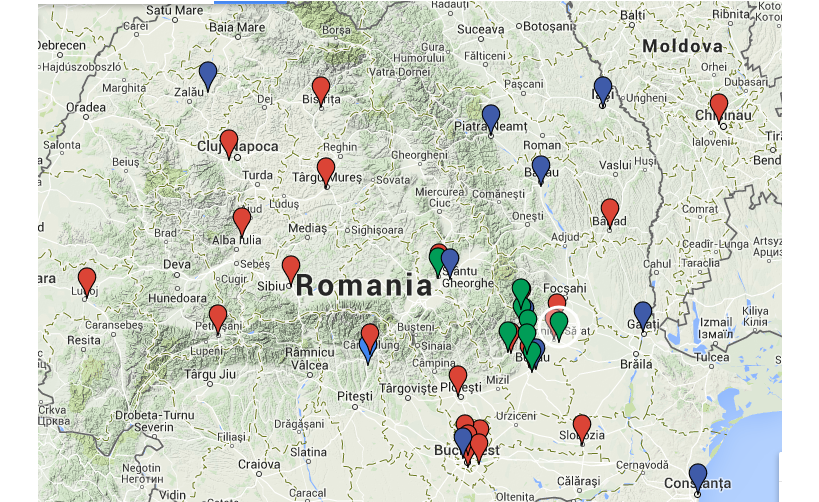Never mind the new year fireworks, the start of 2015 happened with an even bigger bang, at least if you happened to be in Romania, Moldova or the Ukraine. The early hours of January 7th saw a massive fireball over the region, culminating in an explosion loud enough to wake people, and causing many to call the emergency services to report the event. In Romania reports of sightings have come in from across the country, putting the time of the explosion at 3:05 EET (01:05 UT), with people hearing the explosion in the counties of Buzau, Vrancea and Covasna.
So far over 50 recordings and eye witness reports have been collected by the IMO, many from surveillance cameras recording sudden brightening of whatever outside area was being monitored. A compilation of videos of the event, as recorded by security cameras, has been posted on youtube.
The map below shows the location of the reports received so far, red dots are from surveillance cameras, the blue markers are visual reports from witnesses, and the green dots are reports from those who heard the terminal explosion.

Image by Raul Truta, compiled from online reports.
Red: detections by cameras, blue: visual observations, green: reports of sound heard.
The reports from Romania of the January 7th fireball put the maximum apparent magnitude of -16, brighter than the full Moon (-13). Roughly one in 1,200 meteors is brighter than magnitude -5, while only one on 12,000 meteors reaches magnitude -8 or brighter, so fireball events like this one are rare.
So far, information on the event is sparse. The explosion appears to have occurred at a height of roughly 55 kilometres and, although some fireballs do result in meteorite fragments reaching the ground, it is likely that in this case the meteoroid completely disintegrated.
Whether a fall occurs or not, the details of events like this can only be determined from combining the information from many eyewitness reports. If you see a bright fireball event like this, you can help researchers by reporting what you saw in as much detail as possible. You can find further information on meteors and other related events, and advice on how to observe and report them, visit the observations section of the IMO website.




 You saw something bright and fast? Like a huge shooting star? Report it: it may be a fireball.
You saw something bright and fast? Like a huge shooting star? Report it: it may be a fireball.  You counted meteors last night? Share your results with us!
You counted meteors last night? Share your results with us!  You took a photo of a meteor or fireball? You have a screenshot of your cam? Share it with us!
You took a photo of a meteor or fireball? You have a screenshot of your cam? Share it with us!  You caught a meteor or fireball on video? Share your video with us!
You caught a meteor or fireball on video? Share your video with us!